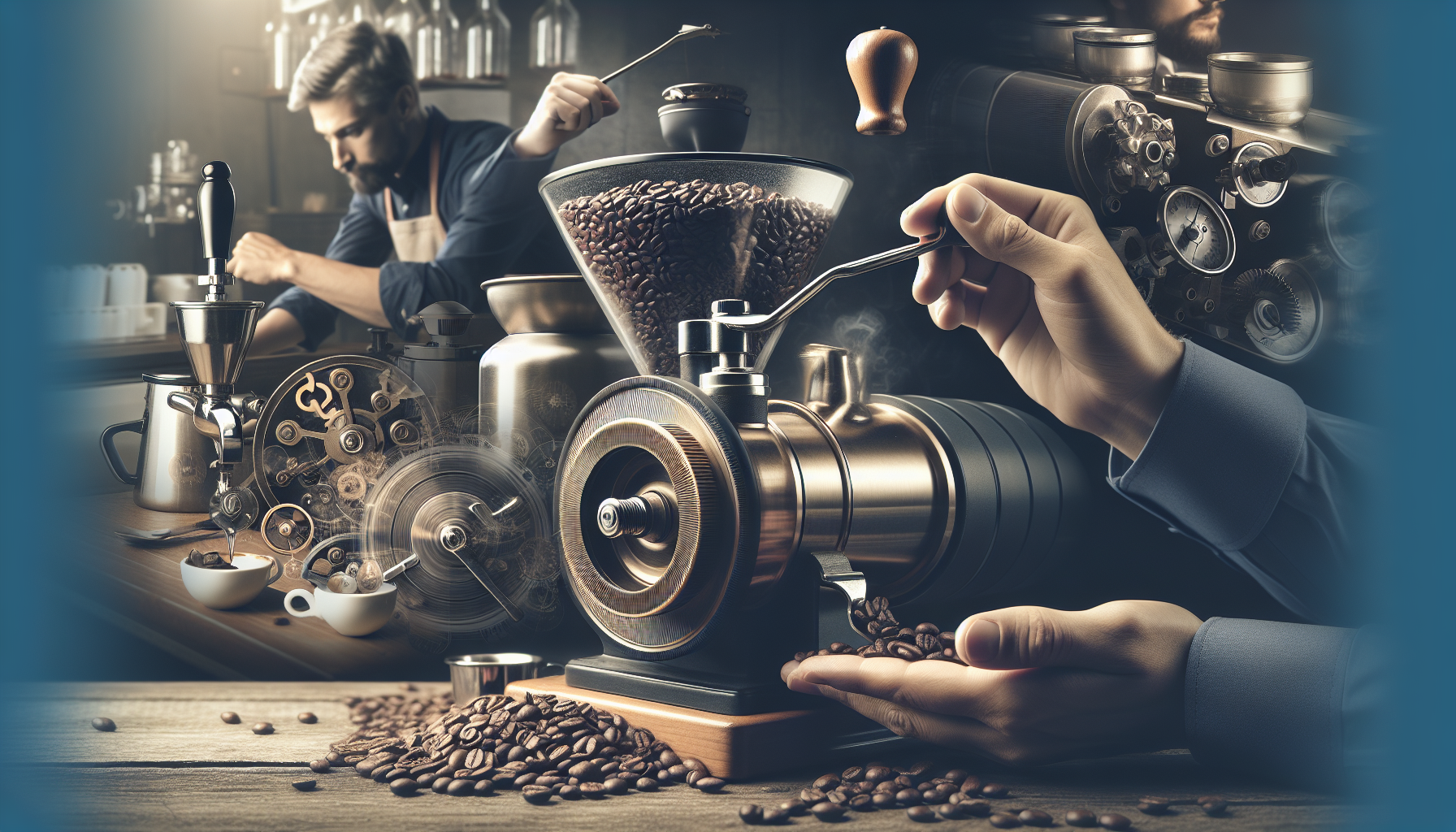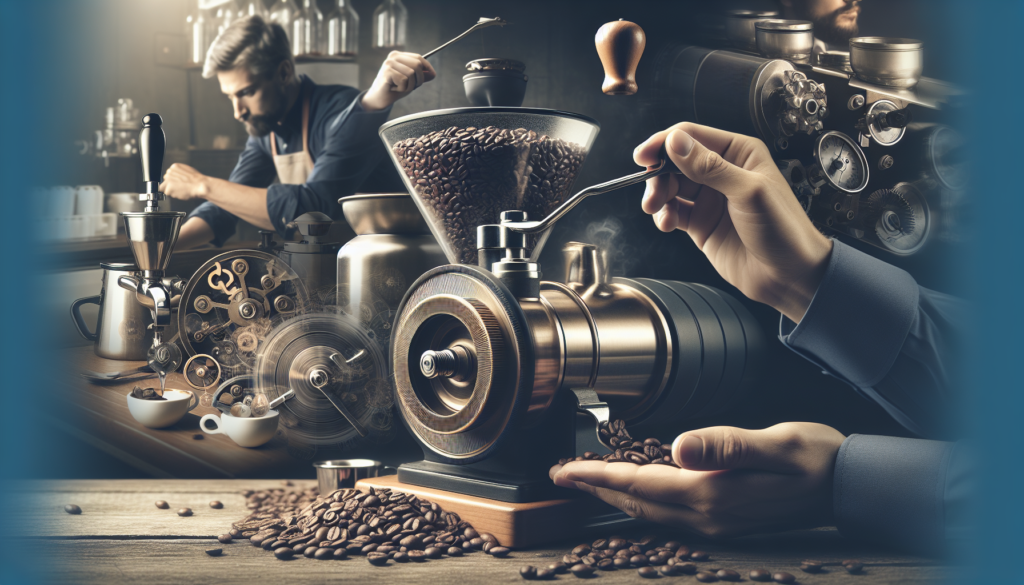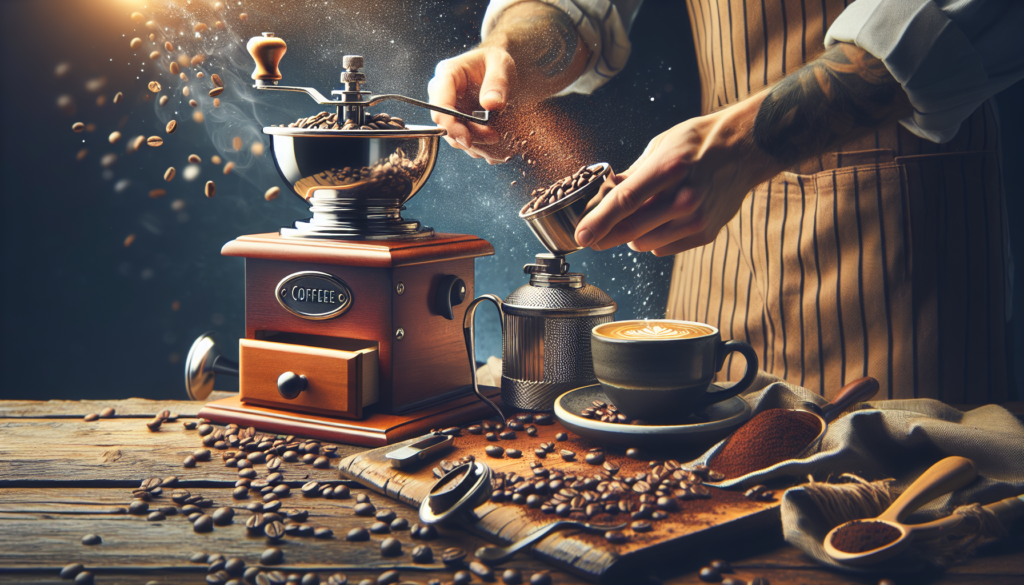
Are you looking to elevate your coffee grinding skills to a professional level? This article, from the perspective of a seasoned barista, offers valuable tips and tricks to help you achieve the perfect grind every time. From understanding the importance of grind size to choosing the right grinder, you’ll gain insider knowledge that will make you a coffee connoisseur in no time. Discover the secrets of professional coffee grinding and unlock a whole new world of flavor and aroma in your daily cup of joe.

Choosing the right grinder
Blade grinders vs. burr grinders
When it comes to choosing a coffee grinder, one of the first decisions you’ll need to make is whether to go with a blade grinder or a burr grinder. While blade grinders may be more affordable, they tend to produce inconsistent grind sizes due to their rotating blades. On the other hand, burr grinders offer a more precise and consistent grind, thanks to the two grinding surfaces that crush the coffee beans. For the best taste and control over your brew, investing in a burr grinder is highly recommended.
Manual vs. electric grinders
Another key decision in choosing a grinder is whether to opt for a manual or electric model. Manual grinders are a popular choice for coffee enthusiasts who enjoy the process of hand-grinding their beans. They offer greater control over grind size and can be a portable option for those who love to travel. However, if convenience and speed are your priorities, an electric grinder is the way to go. With the push of a button, you can get consistent grinds in no time.
Considerations for commercial use
For those in the coffee business, such as cafe owners or professional baristas, choosing a grinder for commercial use requires additional considerations. Commercial grinders are designed to handle high volumes of coffee and feature stronger motors and larger hoppers to meet the demands of a bustling coffee shop. They also offer advanced features like programmable dosing options and customizable grind profiles, making it easier to meet the specific needs of your customers.
Understanding grind size
The importance of grind size
Grind size plays a significant role in creating a delicious cup of coffee, as it affects the extraction process. Different brewing methods require different grind sizes to achieve optimal flavor. If the grind size is too coarse, the water will flow through too quickly, resulting in an under-extracted and weak cup of coffee. On the other hand, if the grind size is too fine, the water will struggle to pass through, leading to over-extraction and a bitter taste. Finding the right grind size is crucial for achieving a balanced and flavorful brew.
Different grind sizes for various brewing methods
To achieve the best flavor from your coffee, it’s important to match the grind size to your chosen brewing method. For example, a coarse grind is ideal for French press brewing, as the large grounds allow for a longer extraction time. On the other hand, a medium grind works well for drip coffee makers, while a fine grind is necessary for espresso machines. By understanding the grind size requirements of different brewing methods, you can ensure that each cup of coffee you make is perfectly tailored to your preferences.
Adjusting grind size for desired extraction
If you find that your coffee tastes under or over-extracted, it may be time to adjust the grind size. To increase extraction, try making the grind size finer, allowing the water to spend more time in contact with the coffee. Conversely, if your coffee is over-extracted, a coarser grind will help to reduce the contact time and create a more balanced flavor. Experiment with small adjustments to find the perfect grind size for your desired extraction and taste preference.
Grinding for espresso
The role of espresso in specialty coffee
Espresso holds a special place in the world of specialty coffee. It is a concentrated and bold brew that requires precise extraction to achieve its full potential. With the right grinder, you can unlock the rich flavors and creamy texture that make espresso a beloved choice for coffee aficionados. Whether you enjoy a traditional espresso shot or use it as a base for various specialty drinks like lattes and cappuccinos, having control over the grind size is essential for a perfect espresso experience.
Selecting the ideal grind size for espresso
When grinding coffee for espresso, it’s crucial to find the ideal grind size to achieve the perfect extraction. Generally, espresso requires a fine grind that is slightly coarser than powdered sugar. This grind size allows for optimal extraction, balancing the flavors and aromas of the coffee beans. However, it’s essential to note that the ideal grind size may vary depending on the specific espresso machine and the coffee beans you’re using. Experimentation and dialing in your grind are key to finding the perfect sweet spot for your espresso shots.
Tamping techniques for optimal extraction
In addition to the grind size, tamping plays a vital role in the espresso brewing process. Tamping refers to the act of compacting the coffee grounds evenly in the portafilter before brewing. It ensures proper water flow through the grounds, aiding in the extraction process. When tamping, apply firm and consistent pressure to create an even surface of coffee. Avoid exerting too much force, as this can lead to channeling and uneven extraction. With practice, you’ll develop a tamping technique that allows for optimal extraction and a flavorful espresso shot.

Mastering consistency
Why consistency is crucial
Consistency is key when it comes to brewing a great cup of coffee. Whether you’re a professional barista or a home brewing enthusiast, maintaining a consistent grind size is paramount to achieving consistent flavor and extraction. Coffee grounds of different sizes will extract at different rates, leading to variations in taste and strength. By prioritizing consistency in your grinding process, you can ensure that each cup of coffee you make is of the highest quality and meets the expectations of your customers or personal preferences.
Techniques to achieve consistent grind size
To achieve consistent grind size, there are a few techniques you can employ. First and foremost, invest in a high-quality grinder that offers precise grind settings and a stable grinding mechanism. Regularly calibrate your grinder to ensure it remains accurate over time. Additionally, consider using a scale to measure the amount of coffee beans and the resulting grounds, allowing you to reproduce the same grind size consistently. Finally, develop a systematic and careful approach to grinding, taking into account factors like speed, duration, and grind size adjustments.
Maintaining consistent brewing results
Consistency in grinding is only one part of the equation for a great cup of coffee. To maintain consistent brewing results, it’s essential to pay attention to other variables like water temperature, brew time, and coffee-to-water ratio. By carefully controlling each element in the brewing process, you can ensure that your coffee tastes the same every time. Keep a record of your brewing parameters and make minor adjustments as needed to achieve the desired flavor profile consistently. With practice and attention to detail, you’ll become a master of consistency in coffee brewing.
Preserving coffee freshness
Understanding the impact of grinding on coffee freshness
The moment coffee beans are ground, they begin to lose their freshness. Grinding exposes a larger surface area of the beans to air, accelerating the oxidation process and leading to a loss of flavor and aroma. To preserve the freshness of your coffee for as long as possible, it’s best to grind your beans just before brewing. By doing so, you can ensure that the flavors and aromas are at their peak, resulting in a more enjoyable cup of coffee.
Storage tips for ground coffee
To extend the freshness of your ground coffee, proper storage is essential. Choose an airtight container that is opaque or UV-protected to shield the coffee from light. Store the container in a cool, dry place away from direct sunlight and moisture. Avoid storing coffee grounds in the refrigerator or freezer, as the fluctuating temperatures can affect the taste and quality of the coffee. Additionally, only grind the amount of coffee you need for immediate use to minimize exposure to air and ensure the freshest flavor.
Minimizing coffee waste
Coffee waste can be a concern when grinding coffee, especially if you’re operating on a commercial scale. To minimize waste, consider using a grinder with programmable dosing options, allowing you to grind the exact amount of coffee needed for each brew. This not only helps to maintain consistency but also reduces excess coffee grounds. Additionally, regularly assess your coffee consumption patterns and adjust your grinding quantities accordingly. By minimizing coffee waste, you can make the most of your resources and reduce unnecessary expenses.
Dialing in your grind
The process of dialing in
Dialing in your grind refers to the process of adjusting the grind size and other variables to achieve the desired flavor and extraction. It involves testing and making small incremental changes to find the perfect brewing parameters for a particular coffee bean or blend. To begin dialing in, start with the recommended grind size for your brewing method and make small adjustments from there. Keep notes on the changes you make and the resulting taste, allowing you to refine your process and create consistently great coffee.
Recognizing signs of under and over-extraction
When dialing in your grind, it’s important to recognize the signs of under and over-extraction. An under-extracted coffee typically tastes weak, sour, or acidic, lacking the full flavors and body of a properly extracted brew. On the other hand, an over-extracted coffee can taste bitter, harsh, or burnt. By tasting your coffee and identifying these characteristics, you can adjust your grind size accordingly to achieve a well-balanced and flavorful cup.
Adjusting grind settings for optimal flavor
To achieve optimal flavor, it’s essential to adjust your grind settings based on the desired characteristics of your coffee. Finer grind settings generally lead to a more intense and flavorful cup, while coarser grind settings result in a milder and lighter taste. Pay attention to the unique qualities of each coffee you brew, as different origins, roasts, and blends may require adjustments to unlock the best flavor profile. By fine-tuning your grind settings, you can truly highlight the nuances and complexities of the coffee you are working with.
Avoiding common mistakes
Overfilling the grinder
One common mistake when using a coffee grinder is overfilling the hopper or chamber. Overfilling can cause the grinder to become jammed or produce inconsistent grind sizes. To avoid this, follow the manufacturer’s guidelines for the maximum amount of coffee beans that can be ground at once. By grinding in smaller batches, you can ensure a more even and consistent outcome.
Not cleaning the grinder regularly
Regular cleaning of your grinder is essential to maintain its performance and prevent the buildup of coffee oils and residue. Failure to clean the grinder regularly can result in stale flavors, clogged burrs, and decreased grinding efficiency. To clean your grinder, refer to the manufacturer’s instructions for the specific model you own. This may involve removing burrs, using a brush to clean the grinding chamber, or using specialized cleaning products. By incorporating regular cleaning into your routine, you can ensure a fresher, more consistent grind every time.
Inconsistent distribution of coffee grounds
Uneven distribution of coffee grounds can lead to uneven extraction and an inconsistent flavor profile in the final brew. To achieve even distribution, consider using a distribution tool or a simple leveling technique with a straight edge. After grinding, distribute the coffee grounds evenly in the portafilter or brewing apparatus by gently tapping and leveling the surface. This creates a uniform bed of coffee for water to evenly extract from, resulting in a more balanced and flavorful cup.
Maximizing efficiency
Time-saving techniques for coffee grinding
For those looking to streamline their coffee grinding process and maximize efficiency, there are a few time-saving techniques to consider. One option is to pre-weigh your coffee beans ahead of time, allowing you to quickly dose the exact amount needed for each brew. Another technique is to practice multitasking while the grinder is running, such as setting up filters or preparing other components of the brewing process. By optimizing your workflow, you can save valuable time and create more time for enjoying your coffee.
Batch grinding vs. on-demand grinding
When it comes to grinding coffee, two common approaches are batch grinding and on-demand grinding. Batch grinding involves grinding a larger quantity of coffee beans at once, storing the excess for future use. This method is suitable for situations where larger volumes of coffee are needed quickly, such as in a busy coffee shop. On the other hand, on-demand grinding involves grinding coffee beans as needed, ensuring the freshest grounds for each brew. This method is ideal for smaller-scale operations or home use, where freshness and flavor are prioritized over speed and quantity.
Streamlining grinding workflow
To streamline your grinding workflow, it’s important to organize your equipment and workspace efficiently. Keep your grinder, coffee beans, and other brewing tools easily accessible and arranged in a logical order. Clean and maintain your grinder regularly to prevent any delays or malfunctions. Additionally, consider investing in a grinder with features like programmable dosing or customizable grind profiles, which can further automate and speed up the grinding process. By optimizing your workflow, you can save time and energy while consistently producing high-quality coffee.
Utilizing advanced features
Exploring programmable dosing options
Many advanced grinders offer programmable dosing options, allowing you to customize the amount of coffee ground for each brew. This feature is particularly useful for commercial settings, where consistency and efficiency are crucial. By programming the desired dose size, you can eliminate the need for manual weighing and measuring, ensuring accuracy and reducing waste. This feature also enables you to create different dose profiles for various coffee blends or brewing methods, giving you greater control and flexibility in your coffee preparation.
Adjusting grind settings for extraction time
Some grinders offer the ability to adjust grind settings based on the desired extraction time. This feature allows you to fine-tune the grind size to achieve the ideal flavor profile, taking into account factors like brew time, roast level, and desired strength. By manipulating the grind settings to match the desired extraction time, you can customize your coffee to suit your personal preferences and explore the vast array of flavors available in different coffee beans.
Customizing grind profiles
Advanced grinders also often come with the option to create and save custom grind profiles. This feature allows you to experiment with different grind sizes, grind times, and other variables to create unique flavor profiles for specific coffee beans or brewing methods. By customizing your grind profiles, you can truly showcase the characteristics of each coffee and create a personalized brewing experience. This level of control and customization is particularly beneficial for coffee professionals and enthusiasts who enjoy exploring the boundaries of flavor and extraction.
Maintenance and troubleshooting
Cleaning and maintaining your grinder
Proper cleaning and maintenance are crucial to prolonging the lifespan and performance of your grinder. Regularly refer to the manufacturer’s instructions for cleaning guidelines specific to your grinder model. This may include brushing or wiping away coffee particles, disassembling and cleaning burrs, or using specialized cleaning products. Additionally, ensure that the grinder is properly lubricated and calibrated to maintain optimum performance. By incorporating a routine maintenance schedule, you can prevent issues and enjoy a consistently high-quality grind.
Identifying and resolving common grinder issues
In case of any issues with your grinder, it’s important to be able to identify and resolve common problems. If you notice uneven grind sizes, it may be a sign that the burrs need to be cleaned or replaced. Excessive noise or grinding inconsistencies can indicate a misalignment or worn parts. Consult the grinder’s manual or reach out to the manufacturer for troubleshooting advice. Being proactive in addressing any problems will ensure that your grinder continues to operate at its best, delivering the perfect grind for your coffee.
When to seek professional assistance
While regular maintenance and troubleshooting can solve many grinder issues, there may come a time when professional assistance is required. If you encounter persistent or severe problems that you are unable to resolve on your own, it’s advisable to seek the help of a professional technician or the manufacturer’s customer support. They will have the expertise and resources to diagnose and repair any complex issues, ensuring that your grinder is back in top condition as quickly as possible. Remember, a well-maintained and properly functioning grinder is essential for consistently delicious coffee.
In conclusion, choosing the right grinder and understanding the variables that affect grind size and extraction are fundamental to achieving a delicious cup of coffee. With the tips and tricks outlined in this article, you can become a master of professional coffee grinding. Whether you’re a barista in a coffee shop or a coffee lover brewing at home, implementing these techniques will elevate your coffee experience and allow you to create consistently flavorful and satisfying brews. So, grab your grinder, experiment with grind sizes, and enjoy the journey of exploring the world of coffee one cup at a time.